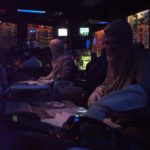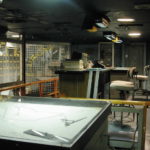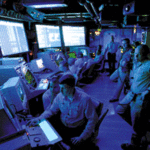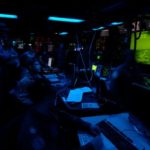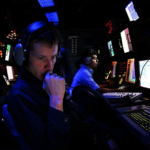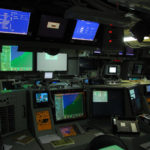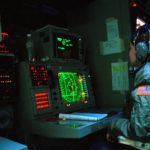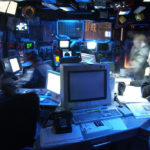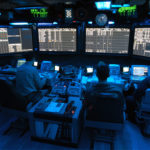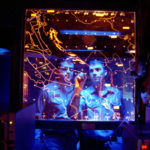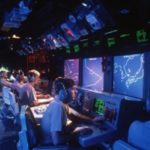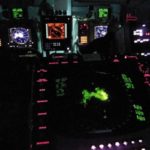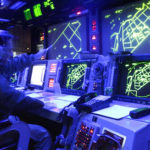This is where all the little details of deploying subordinate ships and troops gets tracked.
–
Table of Contents:
- Introduction
- Main Difference
- Some Specifics
- Conceptual Images
–
Introduction:
The Operations Room (also known as the Combat Information Center (CIC), or, under the British system, the Action Information Centre) is the tactical center of a warship or AWAC aircraft providing processed information for command and control of the near battlespace or ‘area of operations’. Within other military commands, rooms serving similar functions are called by the similar “Command Information Center” or simply “Command center“; the number of different terms for spaces that serve much the same function may explain why the plain and generally non-descriptive “Operations Center” is a prevalent term.
Regardless of the vessel or command locus, each CIC organizes and processes information into a form more convenient and usable by the commander in authority. Each CIC funnels communications and data received over multiple channels, which is then organized, evaluated, weighted and arranged to provide ordered timely information flow to the battle command staff under the control of the CIC officer and his deputies.
–
Main Difference:
The Bridge of a ship manages the overall course and operations, not individual fighter-craft, etc..
The CDC/CIC manages specific movements of every individual subordinate craft, such as fighter-jets and supporting air/Spacecraft, and is much-more focused on the combat than the ship-steering.
While the Bridge officers often communicate with the commanders of other major vessels, worlds, etc., the officers of/in the CDC/CIC communicate with their own ship’s pilots, reconnaissance team-leaders, etc..
–
Some Specifics:
On many of the view-screens of/in this room… the officers will be able to see not only the exact locations of their deployed subordinates, but circles and cones indicating the ranges and pointed-directions of the different systems (weapon, detection/sensor, communication, and other) of those deployed individuals. This helps them orchestrate where to move each, such that certain craft get into range of others at the right times. It takes a lot of the multitasking, memorizing, and guesswork out of their already very-complex ‘game’/tasking.
Often, if they have enough sensor-data and/or other intel’, their view-screens will even be able to show such circles (ranges) and cones (pointed-directions / fields-of-fire) of the enemies their ship has detected / been tracking.
..
2024 August 26 Monday note: There is a threshold after which there are too many icons on the screens in here for the controllers/operators/sailors to make sense of, but there are numerous laws/rules regarding ship and fighter dispersion to keep the risk of that happening extremely low.
Also, skilled operators in here can sometimes deduce when one of the fighters (Space-jets) or other craft they are responsible for advising is being jammed or otherwise interfered with; based on uncommon data streaming in from it and/or adjacent craft (even when those craft are flying beyond the range of TNH sensors which handle detecting that sort of interference attempted against TNH itself).
–
–

